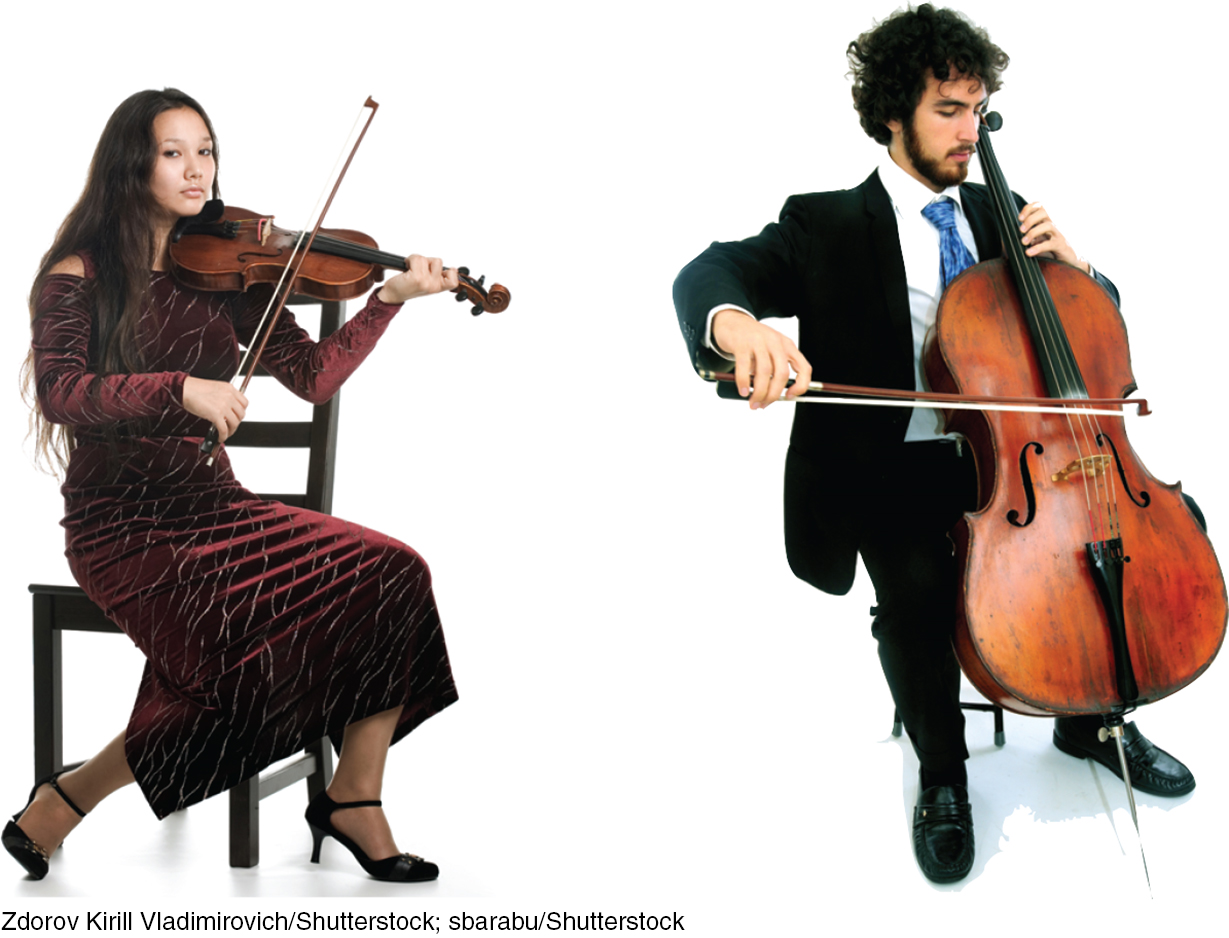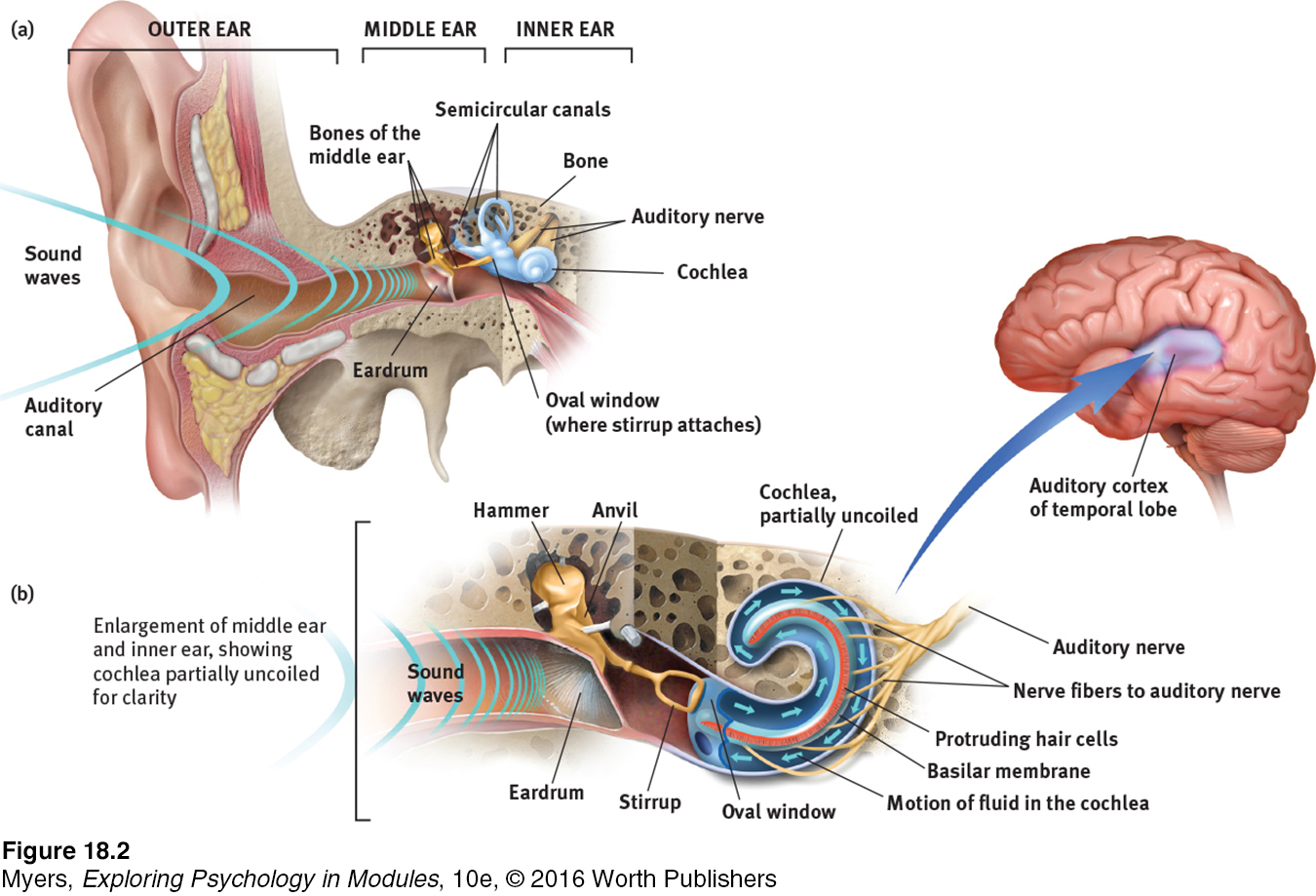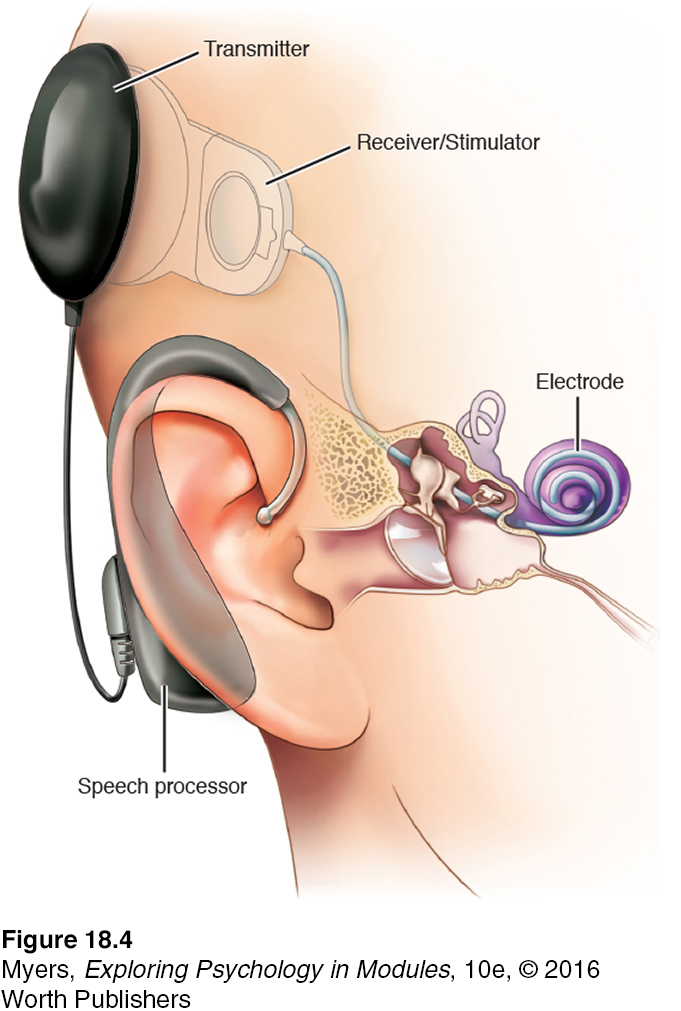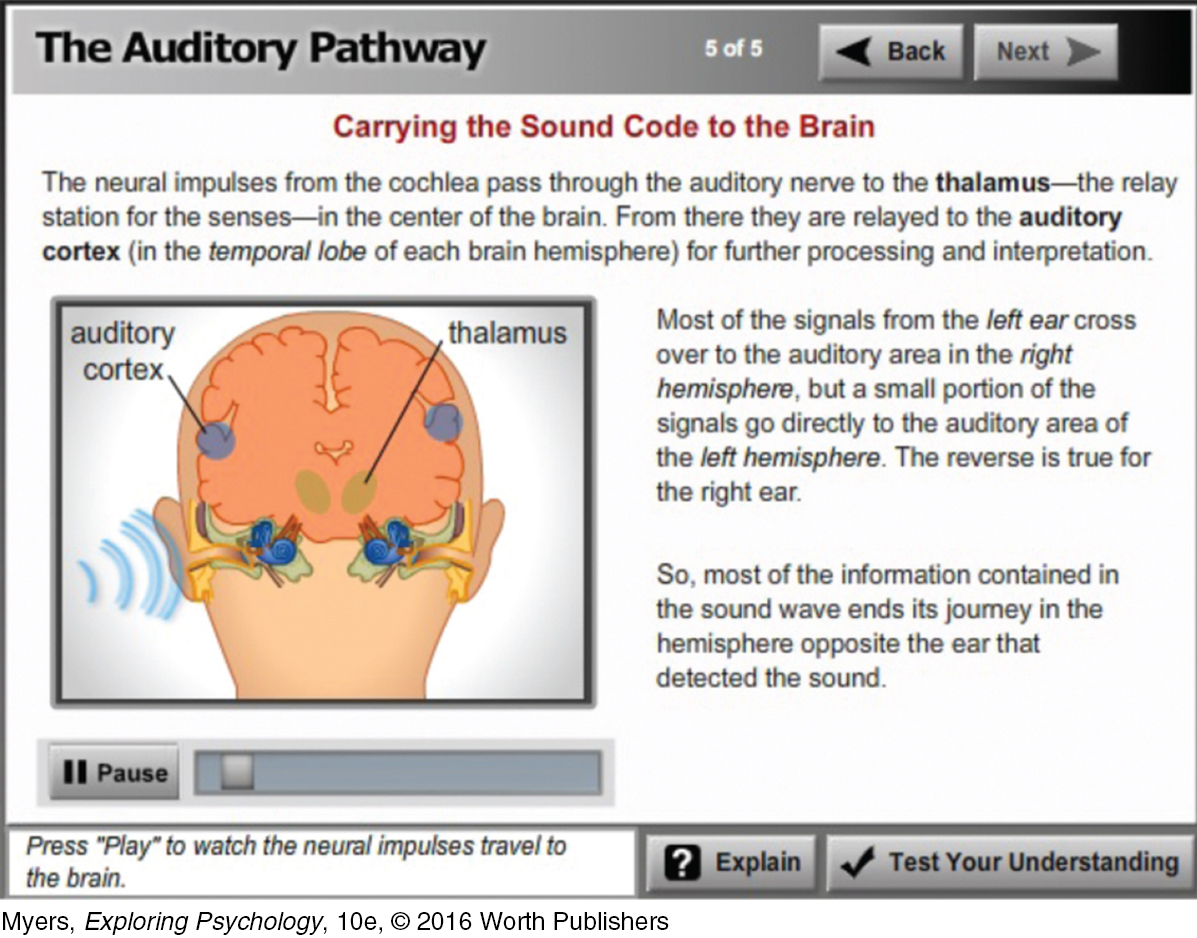18.1 Hearing
audition the sense or act of hearing.
Like our other senses, our audition, or hearing, helps us adapt and survive. Hearing people share information invisibly—
Most of us, however, can hear a wide range of sounds, and the ones we hear best are those in the range of the human voice. With normal hearing, we are remarkably sensitive to faint sounds, such as a child’s whimper. (If our ears were only slightly more sensitive, we would hear a constant hiss from the movement of air molecules.) We are also remarkably attuned to sound variations. Among thousands of possible human voices, we easily recognize an unseen friend’s, from the moment she says “Hi.” Moreover, hearing is fast. “It might take you a full second to notice something out of the corner of your eye, turn your head toward it, recognize it, and respond to it,” notes auditory neuroscientist Seth Horowitz (2012). “The same reaction to a new or sudden sound happens at least 10 times as fast.” A fraction of a second after such events stimulate the ear’s receptors, millions of neurons have simultaneously coordinated in extracting the essential features, comparing them with past experience, and identifying the stimulus (Freeman, 1991). For hearing as for our other senses, we wonder: How do we do it?
The Stimulus Input: Sound Waves
18-
Draw a bow across a violin, and you will unleash the energy of sound waves. Jostling molecules of air, each bumping into the next, create waves of compressed and expanded air, like the ripples on a pond circling out from a tossed stone. As we swim in our ocean of moving air molecules, our ears detect these brief air pressure changes.
frequency the number of complete wavelengths that pass a point in a given time (for example, per second).
pitch a tone’s experienced highness or lowness; depends on frequency.
Like light waves, sound waves vary in shape (FIGURE 18.1). The height, or amplitude, of sound waves determines their loudness. Their length, or frequency, determines the pitch we experience. Long waves have low frequency—


We measure sounds in decibels, with zero decibels representing the absolute threshold for hearing. Every 10 decibels correspond to a tenfold increase in sound intensity. Thus, normal conversation (60 decibels) is 10,000 times more intense than a 20-
The Ear
18-
middle ear the chamber between the eardrum and cochlea containing three tiny bones (hammer, anvil, and stirrup) that concentrate the vibrations of the eardrum on the cochlea’s oval window.
The intricate process that transforms vibrating air into nerve impulses, which our brain decodes as sounds, begins when sound waves enter the outer ear. An elaborate mechanical chain reaction begins as the visible outer ear channels the waves through the auditory canal to the eardrum, a tight membrane, causing it to vibrate (FIGURE 18.2). In the middle ear, a piston made of three tiny bones (the hammer, anvil, and stirrup) picks up the vibrations and transmits them to the cochlea, a snail-
cochlea [KOHK-
inner ear the innermost part of the ear, containing the cochlea, semicircular canals, and vestibular sacs.

Perhaps the most intriguing part of the hearing process is the hair cells—
sensorineural hearing loss the most common form of hearing loss, also called nerve deafness; caused by damage to the cochlea’s receptor cells or to the auditory nerves.
conduction hearing loss less common form of hearing loss, caused by damage to the mechanical system that conducts sound waves to the cochlea.
Across the world, 360 million people are challenged by hearing loss (WHO, 2012). Damage to the cochlea’s hair cell receptors or their associated nerves can cause sensorineural hearing loss (or nerve deafness). Occasionally, disease damages these receptors, but more often the culprits are biological changes linked with heredity, aging, and prolonged exposure to ear-
The cochlea’s hair cells have been likened to carpet fibers. Walk around on them and they will spring back. But leave a heavy piece of furniture on them and they may never rebound. As a general rule, if we cannot talk over a noise, it is potentially harmful, especially if prolonged and repeated (Roesser, 1998). Such experiences are common when sound exceeds 100 decibels, as might occur when in a frenzied sports arena, playing loud music through headphones, or listening to bagpipes (FIGURE 18.3). Ringing of the ears after exposure to loud sounds indicates that we have been bad to our unhappy hair cells. One study of teen rock concert attendees found that after three hours of sound averaging 99 decibels, 54 percent reported not hearing as well, and 1 in 4 had ringing in their ears. As pain alerts us to possible bodily harm, ringing of the ears alerts us to possible hearing damage. It is hearing’s equivalent of bleeding.


The rate of teen hearing loss, now 1 in 5, has risen by a third since the early 1990s (Shargorodsky et al., 2010). Teen boys more than teen girls or adults blast themselves with loud volumes for long periods (Zogby, 2006). Males’ greater noise exposure may help explain why men’s hearing tends to be less acute than women’s. But regardless of gender, those who spend many hours in a loud nightclub, behind a power mower, or above a jackhammer should wear earplugs. “Condoms or, safer yet, abstinence,” say sex educators. “Earplugs or walk away,” say hearing educators.
cochlear implant a device for converting sounds into electrical signals and stimulating the auditory nerve through electrodes threaded into the cochlea.
For now, the only way to restore hearing for people with nerve deafness is a sort of bionic ear—
RETRIEVE IT
Question
The amplitude of a sound wave determines our perception of ________ (loudness/pitch).
Question
The longer the sound waves are, the ________ (lower/higher) their frequency is and the ________ (lower/higher) their pitch.
Perceiving Loudness, Pitch, and Location
18-
RESPONDING TO LOUD AND SOFT SOUNDS How do we detect loudness? If you guessed that it’s related to the intensity of a hair cell’s response, you’d be wrong. Rather, a soft, pure tone activates only the few hair cells attuned to its frequency. Given louder sounds, neighboring hair cells also respond. Thus, your brain interprets loudness from the number of activated hair cells.
If a hair cell loses sensitivity to soft sounds, it may still respond to loud sounds. This helps explain another surprise: Really loud sounds may seem loud to people with or without normal hearing. As a person with hearing loss, I [DM] used to wonder what really loud music must sound like to people with normal hearing. Now I realize it sounds much the same; where we differ is in our perception of soft sounds.
HEARING DIFFERENT PITCHES How do we know whether a sound is the high-
place theory in hearing, the theory that links the pitch we hear with the place where the cochlea’s membrane is stimulated.
frequency theory in hearing, the theory that the rate of nerve impulses traveling up the auditory nerve matches the frequency of a tone, thus enabling us to sense its pitch. (Also called temporal theory.)
Hermann von Helmholtz’s place theory presumes that we hear different pitches because different sound waves trigger activity at different places along the cochlea’s basilar membrane. Thus, the brain determines a sound’s pitch by recognizing the specific place (on the membrane) that is generating the neural signal. When Nobel laureate-
to- be Georg von Békésy (1957) cut holes in the cochleas of guinea pigs and human cadavers and looked inside with a microscope, he discovered that the cochlea vibrated, rather like a shaken bedsheet, in response to sound. High frequencies produced large vibrations near the beginning of the cochlea’s membrane. Low frequencies vibrated more of the membrane and were not so neatly localized. So, the problem remains: Place theory can explain how we hear high- pitched sounds, but not low- pitched sounds. Page 230Frequency theory (also called temporal theory) suggests an alternative: The brain reads pitch by monitoring the frequency of neural impulses traveling up the auditory nerve. The whole basilar membrane vibrates with the incoming sound wave, triggering neural impulses to the brain at the same rate as the sound wave. If the sound wave has a frequency of 100 waves per second, then 100 pulses per second travel up the auditory nerve. But again, a problem remains: An individual neuron cannot fire faster than 1000 times per second. How, then, can we sense sounds with frequencies above 1000 waves per second (roughly the upper third of a piano keyboard)?
Enter the volley principle: Like soldiers who alternate firing so that some can shoot while others reload, neural cells can alternate firing. By firing in rapid succession, they can achieve a combined frequency above 1000 waves per second.
 For an interactive review of how we perceive sound, visit LaunchPad’s PsychSim 6: The Auditory System. For an animated explanation, visit LaunchPad’s Concept Practice: The Auditory Pathway.
For an interactive review of how we perceive sound, visit LaunchPad’s PsychSim 6: The Auditory System. For an animated explanation, visit LaunchPad’s Concept Practice: The Auditory Pathway.

So, here is our current thinking on how we discriminate pitch:
Place theory best explains how we sense high pitches.
Frequency theory, extended by the volley principle, best explains how we sense low pitches.
Some combination of place and frequency theories seems to handle the pitches in the intermediate range.
RETRIEVE IT
Question
Which theory of pitch perception would best explain a symphony audience's enjoyment of a high-
LOCATING SOUNDS Why don’t we have one big ear—
